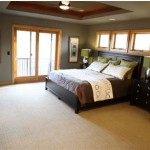Room Colour Decoration
The colour of a room can have a significant impact on its mood and atmosphere. When choosing a colour scheme for a room, it is important to consider the function of the room, the amount of natural light it receives, and the personal preferences of the occupants. Different colours evoke different emotions and can create a variety of effects. For example, warm colours such as red, orange, and yellow can create a sense of energy and excitement, while cool colours such as blue, green, and purple can promote a sense of calm and relaxation. Neutral colours such as white, grey, and black can provide a sense of balance and can be paired with any colour to create a variety of looks.
When choosing a colour scheme, it is also important to consider the amount of natural light a room receives. Rooms with plenty of natural light can support bolder colour choices, while rooms with less natural light may be better suited to lighter colours. The size of a room can also affect the choice of colour. Dark colours can make a small room feel even smaller, while light colours can make a small room feel larger. It is also important to consider the function of the room when choosing a colour scheme. For example, a bedroom may be better suited to calming colours that promote relaxation, while a kitchen may be better suited to energizing colours that encourage activity.
Once you have considered the function of the room, the amount of natural light, and the personal preferences of the occupants, you can begin to choose a colour scheme. There are a few different ways to approach this. One approach is to choose a single colour and use it as the dominant colour in the room. Another approach is to choose a neutral colour and then add accents of colour through furniture, artwork, and accessories. You can also create a colour scheme by choosing two or three colours that complement each other. For example, you could pair a warm colour such as red with a cool colour such as blue. Or, you could pair a neutral colour such as white with a bolder colour such as black.
No matter which approach you choose, it is important to create a balance between the different colours in the room. The dominant colour should be used in moderation, while the accent colours should be used to add interest and excitement. You should also consider the texture of the different colours in the room. Smooth, glossy surfaces reflect light, while rough, matte surfaces absorb light. By combining different textures, you can create a more visually interesting space.
Once you have chosen a colour scheme, you can begin to decorate the room. When choosing furniture, artwork, and accessories, it is important to keep the colour scheme in mind. The colours you choose should complement the colours of the walls and ceiling. You can also use furniture and accessories to add texture and interest to the room. For example, you could add a plush rug to a room with smooth walls to create a more inviting space. Or, you could add some brightly coloured artwork to a room with neutral walls to add a splash of colour.
By following these tips, you can create a room colour scheme that is both beautiful and functional. The colour of a room can have a significant impact on its mood and atmosphere, so it is important to choose a colour scheme that reflects the function of the room and the personal preferences of the occupants.

Bright Room Colours For Your Home Designcafe

Pin On My Saves

Yellow Living Room Colour Ideas Designcafe

50 Popular Living Room Colors Paint Ideas

Hall Colour Combination 15 Ideas Tips For Amazing Transformation Building And Interiors

30 Living Room Color Ideas Best Paint Decor Colors For Rooms

5 Tips To Help You Choose The Right Colour Scheme Home Decorating Ideas

Transform Your Bedroom With These Gorgeous Purple Two Colour Combination Ideas Asian Paints

Room Colour 115 Sublime Wall Schemes Combinations Building And Interiors

Choosing The Right Colour For Your Room Residential Interior Design







